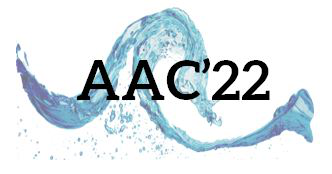Conveners
WG6: Laser-Plasma Acceleration of Ions: Session 4
- Mamiko Nishiuchi (QST)
- Lieselotte Obst-Huebl (Lawrence Berkeley National Lab)
- Igor Pogorelsky (BNL)
WG6: Laser-Plasma Acceleration of Ions: Session 5
- Mamiko Nishiuchi (QST)
- Lieselotte Obst-Huebl (Lawrence Berkeley National Lab)
- Igor Pogorelsky (BNL)
WG6: Laser-Plasma Acceleration of Ions: Session 7
- Lieselotte Obst-Huebl (Lawrence Berkeley National Lab)
- Mamiko Nishiuchi (QST)
- Igor Pogorelsky (BNL)
Relativistic ion beams have wide applications ranging from proton therapy, neutron beam/warm dense matter generation, and fast ignition of fusion pellets. In particular, generating a monoenergetic high energy flux ion beam is of great interest, since fast-ignition scheme of fusion targets require energy fluxes of ~GJ/cm^2. We show that a foam-based target with parabolically shaped front...
Laser plasma-based particle accelerators attract great interest in fields where conventional accelerators reach limits based on size, cost or beam parameters. However, despite the fact that first principles simulations have predicted several advantageous ion acceleration schemes, laser accelerators have not yet reached their full potential in producing simultaneous high-radiation doses at high...
Recently, a novel concept of Laser-Ion Lensing and Acceleration (LILA) [1] has been introduced for highly-efficient generation of monoenergetic low-emittance ion beams. The LILA scheme is based on the illumination of a solid-density target with radially-dependent thickness by an intense circularly polarized (CP) laser pulse, resulting in simultaneous acceleration and focusing of proton beams...
Most of the ion acceleration experiments have been carried out with multi-cycle, Joule-class lasers in the TNSA and RPA regime. The recent developments of few-cycle laser systems with 100 W average power created the technological basis for the generation of ion current of tens of microA consisting of ultrashort particle bunches– something that many applications dream of. Here we present an...
The newly commissioned short focal length, high intensity beamline, named iP2, at the BELLA Center enables frontier experiments in high energy density science. This 1 Hz system provides a focused beam profile of <3 micron in FWHM, resulting in an on-target peak intensity greater than 5e21 W/cm^2 , and a pointing fluctuation on the order of 1 micron. A temporal contrast ratio of <1e-14 on the...
Long-wave infra-red lasers, like the TW CO2 laser at the Accelerator Test Facility (ATF), offer a number of benefits in studying laser-driven ion acceleration, including favorable scaling of the critical density, and the ability to access relativistic regimes at lower intensities. We present recent work studying hole-boring radiation pressure acceleration (HB-RPA) and collisionless shock...
Laser-produced ion beams from 1 um laser-plasma interactions have been a focus of high-energy density physics studies for several decades. Traditionally, these beams have been accelerated via the target normal sheath acceleration (TNSA) mechanism, which has a rootlike scaling of the maximum kinetic energy of protons Ep∞√I, where I is the laser intensity. To enhance TNSA via increase in...
Several setups have recently been proposed to generate ultra-short laser pulses in the 10-100 as range with high energies (0.1-10 J) and a wavelength in the EUV-X range (1-100 nm), either by broadening the spectrum of near-infrared laser pulses to obtain single-cycle pulses that can be converted to single cycle attosecond pulses by a plasma mirror, or by directly using Doppler-boosted...
Ultra-intense lasers are the driving force of the advanced accelerator research (AAR). Extension of their spectral reach from the presently achievable near-IR into the long-wave IR (LWIR) domain opens opportunities to explore new regimes of particle acceleration, gaining deeper insight into laser-plasma interactions, and improve laser accelerator parameters. Longer laser wavelength facilitates...

